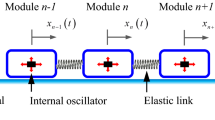Abstract
Soft fault compensation plays an important role in mobile robot locating, mapping, and navigating. It is difficult to achieve fast and accurate compensation for mobile robots because they are usually highly non-linear, non-Gaussian systems with limited computation and memory resources. An adaptive particle filter is presented to compensate two kinds of soft faults for mobile robots, i.e., noise or factor faults of dead reckoning sensors and slippage of wheels. Firstly, the kinematics models and the fault models are discussed, and five kinds of residual features are extracted to detect soft faults. Secondly, an adaptive particle filter is designed for fault compensation, and two kinds of adaptive scheme are discussed: 1) the noise variances of linear speed and yaw rate are adjusted according to residual features; 2) the particle number is adapted according to Kullback-Leibler divergence (KLD) of two approximate distribution denoted with two particle sets with different particles, i.e., increasing particle number if the KLD is large and decreasing particle number if the KLD is small. The theoretic proof is given and experimental results show the efficiency and accuracy of the presented approach.
Similar content being viewed by others
References
Verma V, Gordon G, Simmons R, et al. Real-time fault diagnosis [robot fault diagnosis]. Robot Autom Mag, 2004, 11(2): 56–66
Carlson J, Murphy R R. Reliability analysis of mobile robots. In: Proc ICRA’2003. Taipei: IEEE Press, 2003. 274–281
Roumeliotis S I, Sukhatme G S, Bekey G A. Sensor fault detection and identification in a mobile robot. In: Proc IROS’1998. Victoria: IEEE Press, 1998. 1383–1388
Li J, Zhang H Y. Analysis of fault detection method based on predictive filter approach. Sci China Ser F-Inf Sci, 2005, 48(3): 335–353
Murphy R R. Dempster-Shafer theory for sensor fusion in autonomous mobile robots. IEEE ROBOT, 1998, 14(2): 197–206
Liu H H, Coghill G M. A model-based approach to robot fault diagnosis. Int J Knowl Based Syst, 2005, 18(4): 225–233
Parker L E. ALLIANCE: an architecture for fault tolerant multirobot cooperation. IEEE Trans Robot Autom, 1998, 14(2): 220–240
Duan Z H, Cai Z X, Yu J X. Fault diagnosis and fault tolerant control for mobile robots under unknown environment: a survey (in Chinese). Robot, 2005, 27(4): 373–379
Arulampalam M S, Maskell S, Gordon N, et al. A tutorial on particle filters for on-line nonlinear/non-Gaussian Bayesian tracking. IEEE Signal, 2002, 50(2): 174–188
Thrun S. Particle filters in robotics. In: Proc Uncertainty in AI (UAI). Francisco: Morgan Kaufmann Publishers, 2002. 511–518
Fox D. KLD-sampling: adaptive particle filters. Int J Rob Res, 2003, 22(12): 985–1003
Doucet A, de Freitas N, Murphy K, et al. Rao-Blackwellised particle filtering for dynamic Bayesian networks. In: Proc UAI2000. San Francisco: Morgan Kaufmann, 2000. 176–183
Cai Z X, Zou X B, Wang L, et al. Design of distributed control system for mobile robot (in Chinese). J Central South Univ (Natural Science Edition), 2005, 36(5): 727–732
Laubach S L, Burdick J, Matthies L. Autonomous path planner implemented on the rocky 7 prototype microrover. In: Proc ICRA’98. Leuven: IEEE Press, 1998. 292–297
Glassner A S. Space subdivision for fast ray tracing. IEEE Comput Graph, 1984, 4(10): 15–22
Zou X B. Research on design of control system and environment modeling for a prototype of mobile robot. PhD Thesis. Changsha: Central South University, 2005. 72–75
Karlsson R. Simulation based methods for target tracking. PhD Thesis. Linkoping: Linkoping University, 2002. 112–114
Cover T M, Thomas J A. Elements of Information Theory. New York: Wiley, 1991. 15–25
Author information
Authors and Affiliations
Corresponding author
Additional information
Supported by the National Natural Science Foundation of China (Grant No. 60234030) and National Basic Research Project (Grant No. A1420060159)
Rights and permissions
About this article
Cite this article
Duan, Z., Cai, Z. & Yu, J. An adaptive particle filter for soft fault compensation of mobile robots. Sci. China Ser. F-Inf. Sci. 51, 2033–2046 (2008). https://doi.org/10.1007/s11432-008-0120-3
Received:
Accepted:
Published:
Issue Date:
DOI: https://doi.org/10.1007/s11432-008-0120-3




